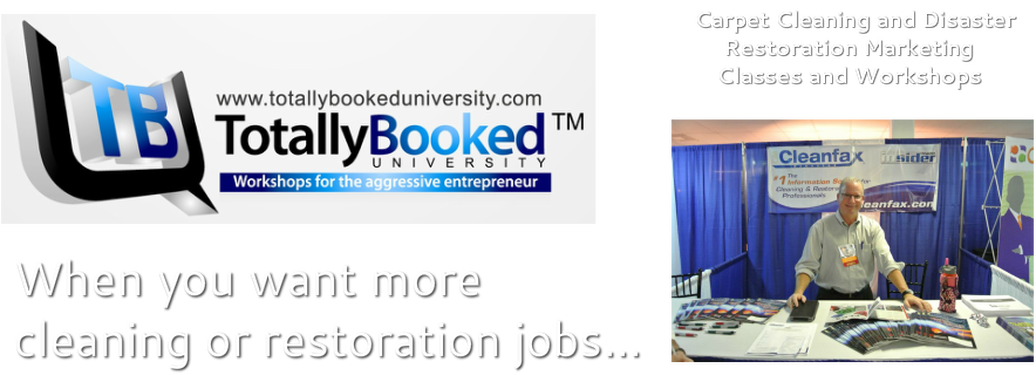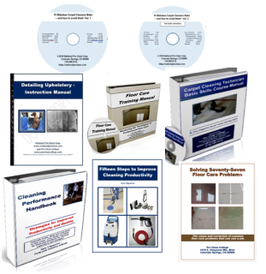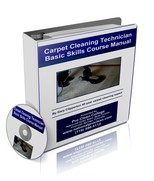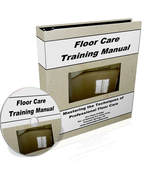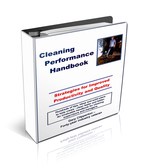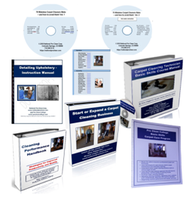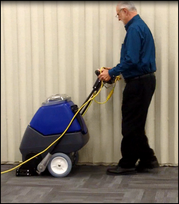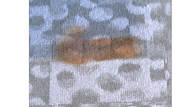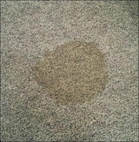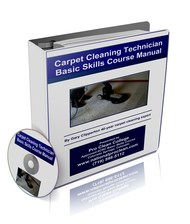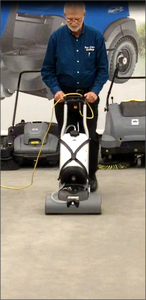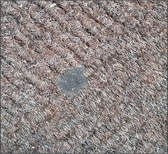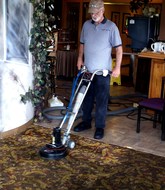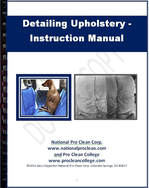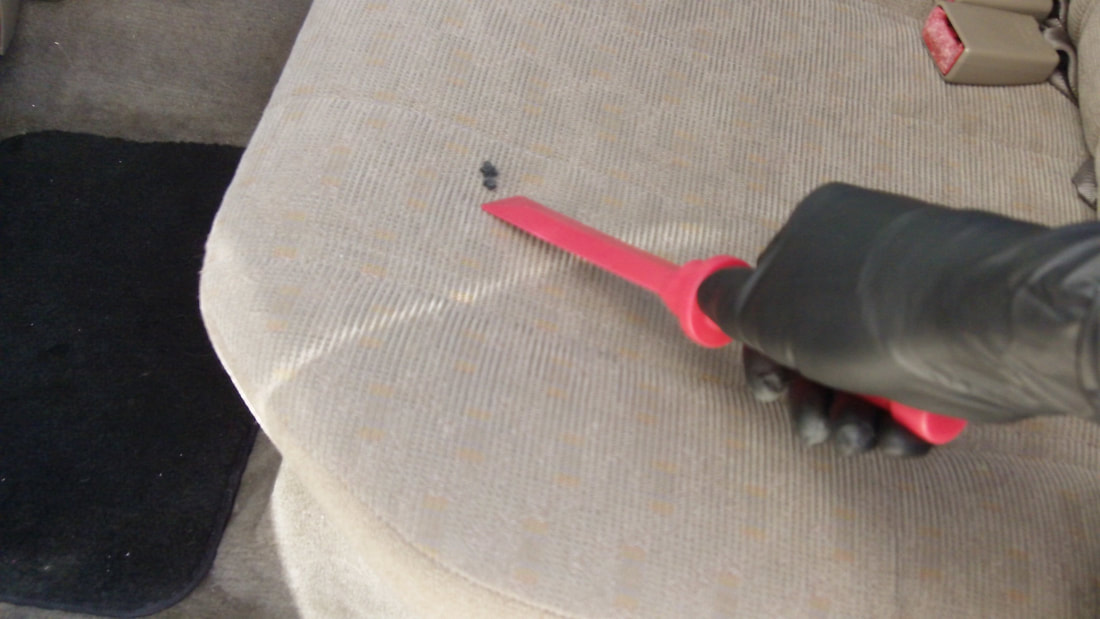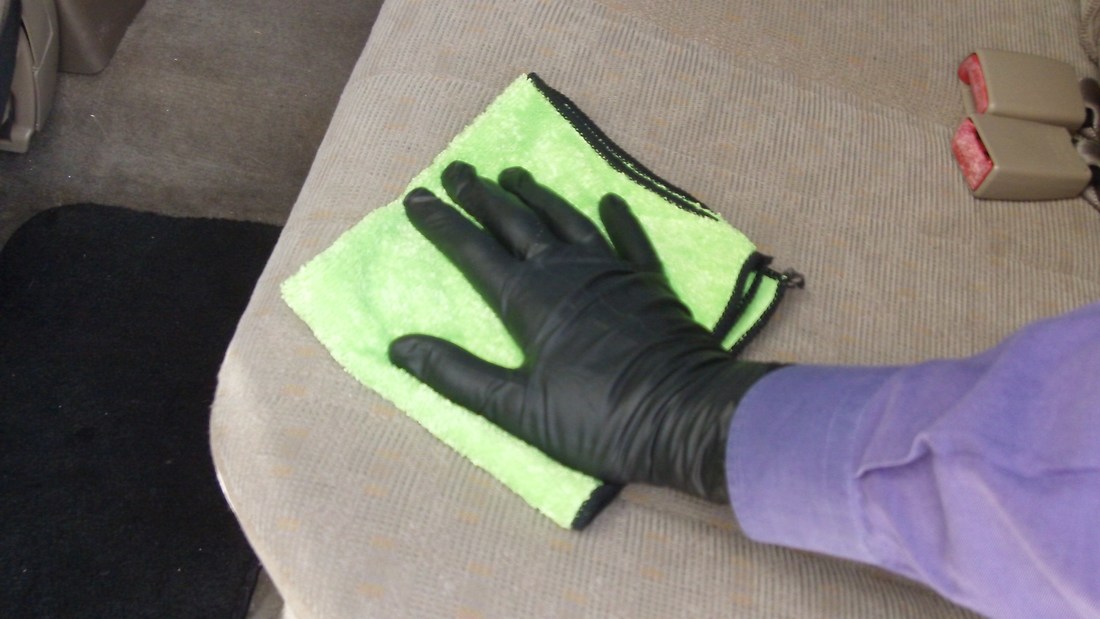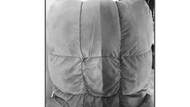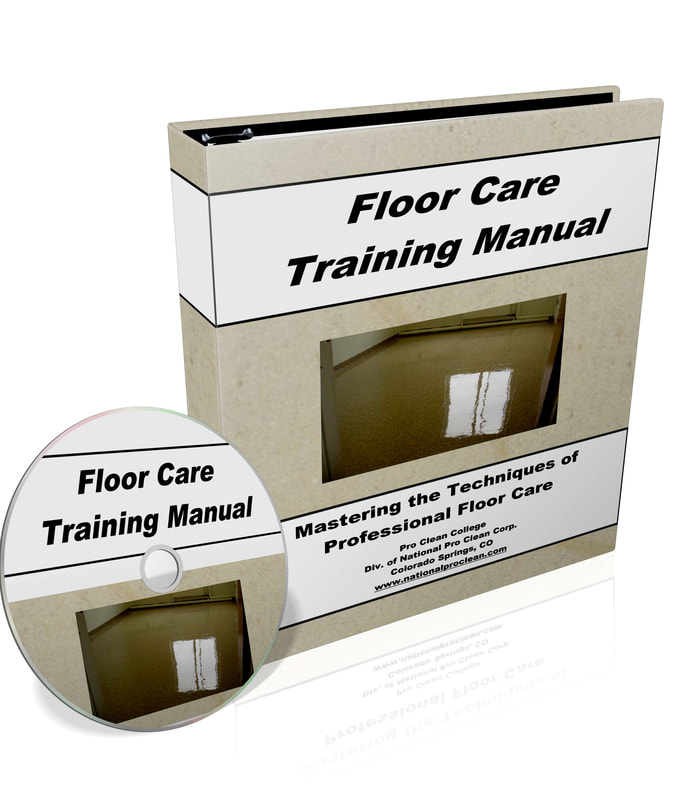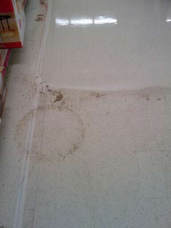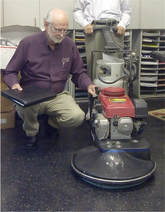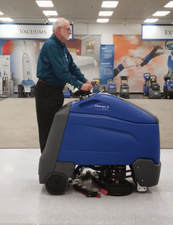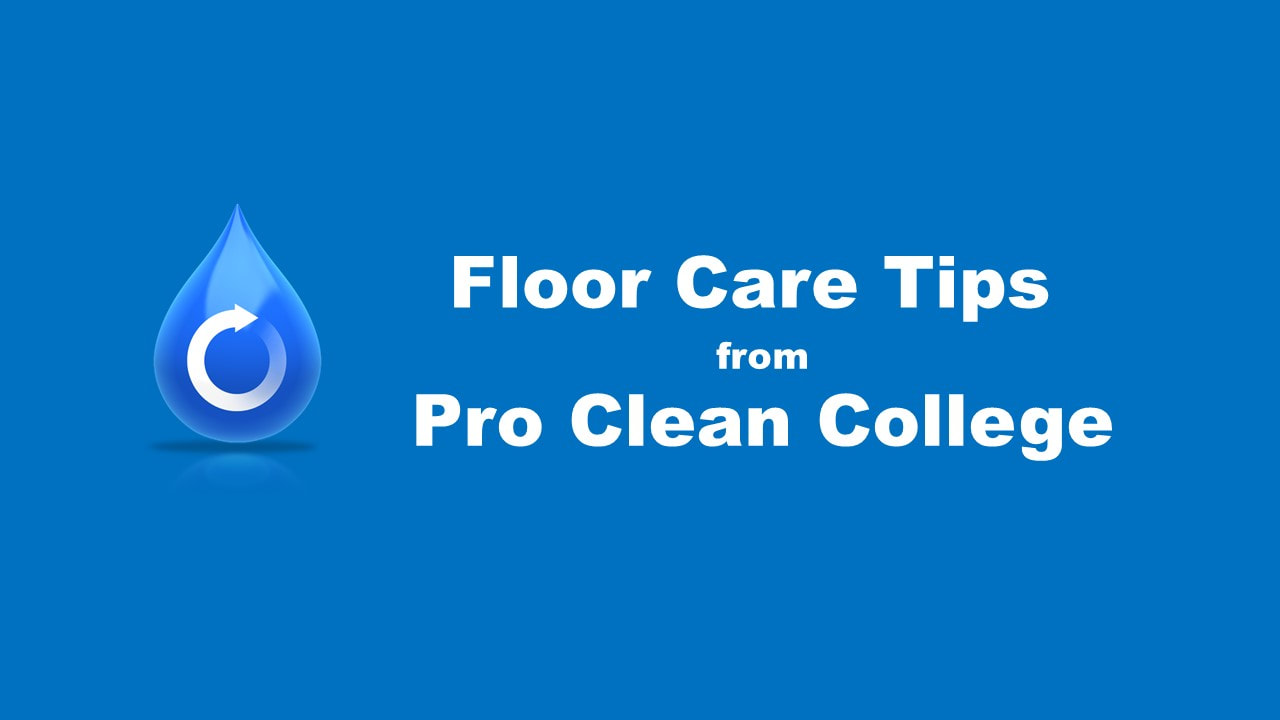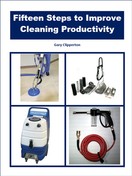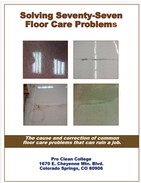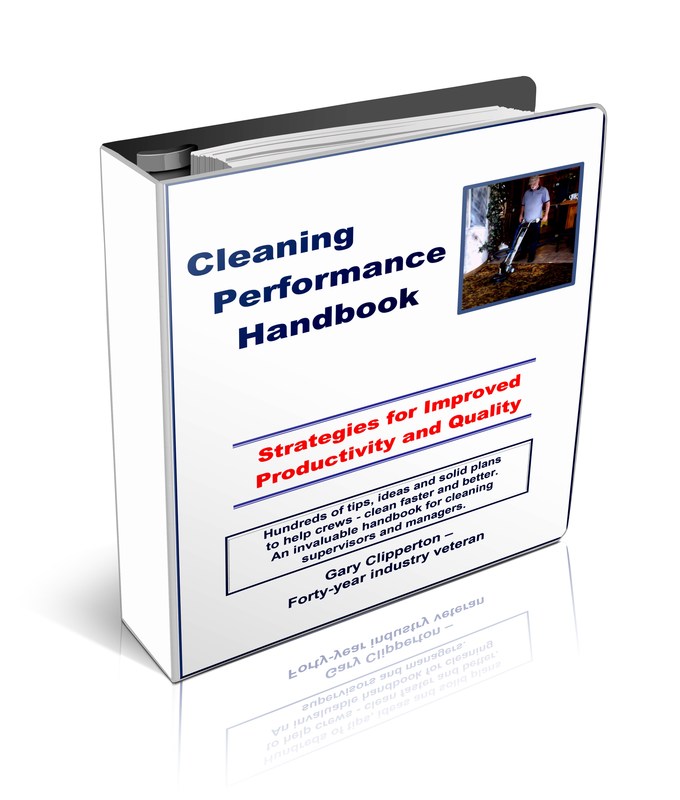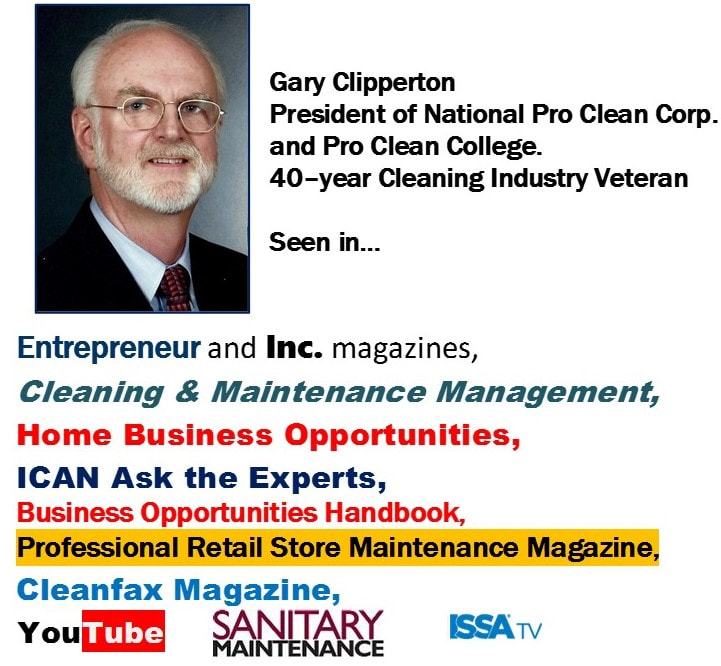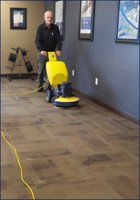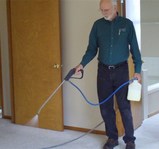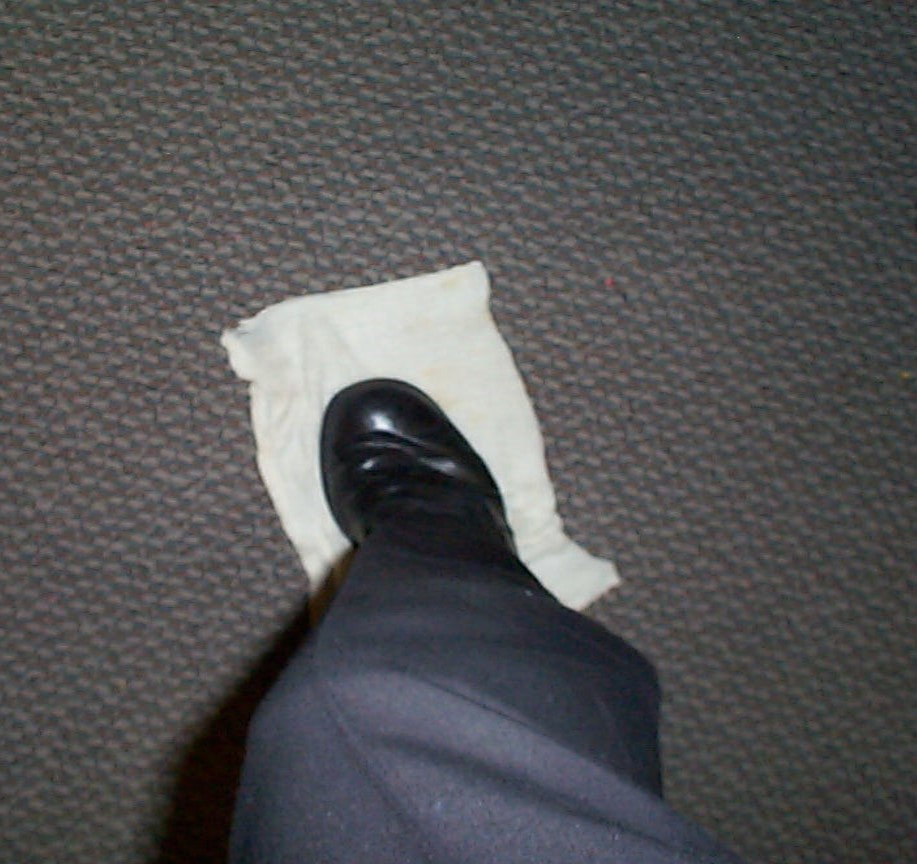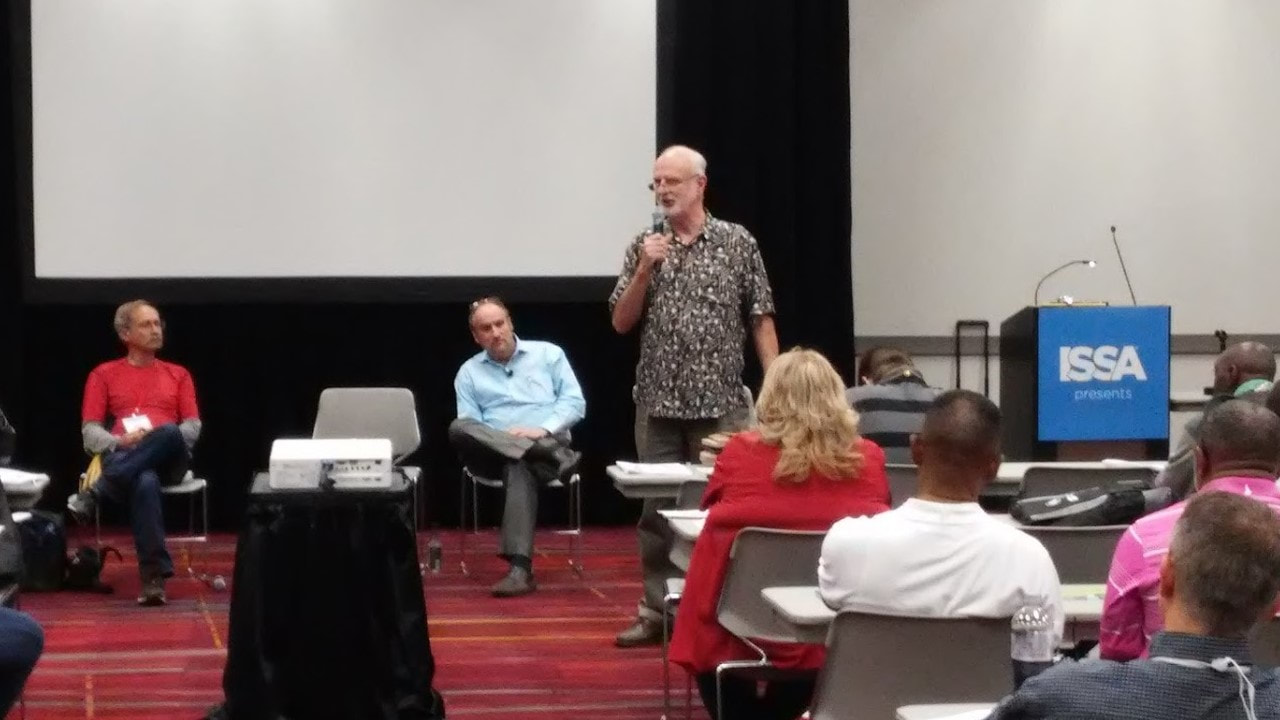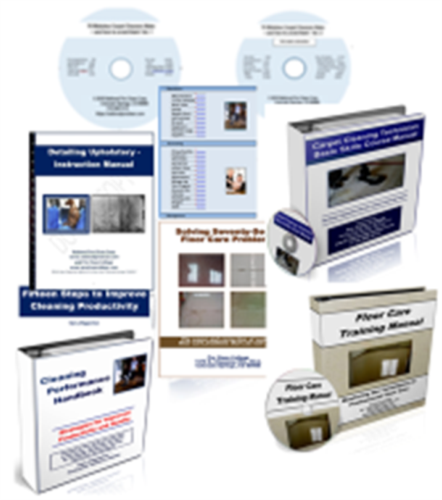Carpet and Floor Care Management and Technical Bundle
Facility, In-House, and Institutional Carpet and Floor Care Training Bundle
|
We’ve bundled together all the solutions for preventing botched jobs and operator error!
This program will take your carpet and floor care operations to the next level. Eliminate dozens of mistakes commonly made by untrained workers. 70 Mistakes Carpet Cleaners Make and How to Avoid Them - Two part video series just released. These are all critical mistakes that can ruin any job. This series will fully train all workers to become experts at troubleshooting and turning out immaculate work. Learn how to curtail inferior results and improve productivity. IICRC Basic Skills Carpet Care Training Program - 100-page manual and 139 slides including test and diploma. Learn the diagnostic and troubleshooting skills that will prevent operator error. Student versions of the IICRC program are also available without the slide shows and videos. Ideal for classroom training with several students who can successfully complete the test and receive an IICRC Diploma. Detailing Upholstery -
Master the techniques of Programmed Floor Care including over 100 tips to improve: dust-mopping , wet-mopping, flat-mop cleaning, burnishing, scrub and top-coat, stripping and refinishing, cleaning grout, polishing stone, and wood and the list goes on... Solving 77 Floor Care Problems - troubleshooting booklet. Learn the most commonly made mistakes that produce inferior outcomes. Become an expert at diagnosing, correcting and preventing floor care problems. Floor Care Tips - 164 slides showing photos of common mistakes and the best way to solve your floor care problems. 15 Steps to Improve Productivity – invaluable workbook Cleaning Performance Handbook - 250-page manual on improving worker productivity and quality. Learn proper steps to train, organize, workload, motivate and keep good workers. With the download version you have all the materials the same day you order. But the choice is yours. E-version same-day download or hard copy printed and mailed to you. Read on … View all the details and benefits of providing a thorough, technical training system for your team Carpet and Floor Care Management and Technical Training Bundle. Here are the products you will supercharge your training program: 70 Mistakes Carpet Cleaners Make – and how to avoid them This exclusive two-part video program will help you on your way to becoming an expert in carpet cleaning. Here are just a few of the topics you will master and the problems you will resolve:
These are all critical mistakes that can ruin any job. This series will fully train all workers. Or, if you are working for someone else, this program will help accelerate your cleaning skills. If you own a carpet business, make sure your competition doesn’t get a head start on landing new accounts. Especially when difficult carpet is not cleaned to the customer’s satisfaction. Master the steps to make carpet look almost new - when possible. If you want to take your operations to the next level, you need to invest in this training program today. Your choice: eversion downloaded to your computer where you can make your own backups and print out the manuals, or you can order the download version plus the hardcopies mailed to you. You will be impressed with these videos containing priceless training skills. Click to Watch preview video IICRC Basic Skills Carpet Care Training Carpet Care Strategies you will Master:
Two modules 1 1/2 hours each: Carpet Maintenance Theory and Carpet Cleaning Diagnostics Note: a third, personalized module is available at an additional cost to include photos of your facility, equipment, chemicals, procedures and staff. Carpet Maintenance Theory: 1 ½ hour module Slide Presentation
Carpet Cleaning Diagnostics 1½ hour module Slide Presentation,
Details of the IICRC diploma: 1. Simply purchase, download, and study the program, including the 100-page instruction manual and two slide presentations. 2. When finished, complete the test found in the back of the manual. Email the answers to us and we will grade it and email a diploma to each student who passes. Students are allowed to re-test should they initially fail the test. 3. The first diploma is free and customers can purchase additional diplomas for as many employees as desired for $25 each. Successful completion of the test is required for each diploma. Student manuals can be purchased for classroom training. Detailing Upholstery Chapter I. Scope and Objectives of this Program Dozens of professional cleaning fundamentals and procedures. Sixteen major skills in detailing upholstery Chapter II. Cleaning 101 Soil composition Fundamentals of cleaning Cleaning basics Indoor air quality Understanding pH Understanding Stain Delamination Chapter III. Supplies and Processes Preparation and Supplies Pre-testing The cleaning process Light clean / Touch ups Cleaning headboards, sun visors, and upholstered dividers Pre spotting Evaluating the soil Understanding cleaning agents Cleaning Codes Chapter IV. Specialty Spot Removal Tips Spotting steps to follow Ink removal Tar removal Asphalt stain removal Urine removal Red dye removal Chewing gum and adhesive removal Candle wax removal Recurring spots Fugitive dye removal Spot removal steps according to the Carpet & Rug Institute Chapter V. Deodorizing Deodorizing carpet and fabric Oxygen based deodorizers Enzymes Biocides Ozone machines Chapter VI. Drying and Protectants Accelerate the drying Fabric protectants Chapter VII. Fibers Cleaning microfiber Checking the fiber type Chapter VIII. Equipment Diagnostics for Hot Water Extractors Six items to check on hot water extractors Was the problem with the chemical, the equipment, or the technician? Ten items to examine. Chapter IX. Q & A - Fifteen more topics to review Chapter X. Safety First – 23 items to remember Chapter XI. Glossary – Definitions of 59 commonly used terms Floor Care Training Manual and Slide Shows In becoming a floor care expert you will learn all of these steps: • Mastering the six steps of Programmed Floor Care. • Three types of door mat systems that reduce grit. • Preventative Maintenance Check list – 29 items to monitor in order to reduce floor damage. • Dust mopping – 30 tips to improve the process. • Improving your flat mop procedures • Wet mopping – choosing the right mop head fiber construction, mop handle, mop bucket and cleaning product. • When to double mop a floor, how to reduce deplying, sources of slips and falls, determining proper moisture levels, 18 steps to improved floor mopping, flat mop selection. • Troubleshooting guide: 7 causes and corrections for dull floors, 6 causes and corrections for streaked floors, and 3 causes and corrections fr slippery floors. • Understanding common floor types: VCT, VAT, Sheet vinyl, Linoleum, Terrazzo, Glazed and Unglazed Ceramic, Brick, Mexican Tile, Concrete, Marble, Slate, Granite, Wood, Rubber and Laminate. • Burnishing and Buffing – basic procedures, pad selection, pad drivers, work objectives, Green Compliance by protecting IAQ, dry buffing and spray buffing with 175 rpm floor machine (9 steps), High-speed burnishing (7 steps), cleaning of pads, propane burnishing (14 safety guidelines and 6 operational guidelines), battery operated equipment and automatic floor scrubbers (15 steps to clean floors). • Floor burnishing Troubleshooting Guide
• Scrub and topcoat Troubleshooting Guide: 3 causes and cures for dried floor finish that contains debris - 3 causes and cures for dried blotches in the floor finish. Causes and cures for lack of uniform gloss, ridges - and stop and start points, and soiled areas in the finished product. • Deep Strip and refinishing of floors – 18 guidelines for chemical safety, how to evaluate buildup levels and stripper concentration dilution ratios (2 test methods), understanding VOC and environmental impact, moving furniture, masking and liquid containment preparations, pad selection, laying out the job, 5 scrubbing tips, determining level of success, 5 tips on improving results, 18 steps for professional floor techs to master, using an automatic scrubber or propane stripper, workloading for larger crews, more operational tips (18 suggestions for improved results). • Proper steps to clean and finish new VCT floors. Strip and refinish Troubleshooting Guide: 2 causes and cures for remaining dark splash marks 2 causes and cures for remaining edge buildup 2 causes and cures for floor finish not totally removed Cause and cure for apparent color loss 2 causes and corrections for floor finish taking too long to dry 3 causes and cures for lap marks appearing in the floor finish Cause and cure for streaks in the floor finish2 causes and cures for floor finish wearing off too soon Cause and cure for floor finish beginning to puddle on the floor Cause and cure for drops of floor finish protruding from the dried finish Cause and cure for scuffs and scratches in freshly applied finish Learn all of the basic guidelines for proper care of ceramic tile, wood floors, laminate, stone and many other floor types. • Floor Care Quality Inspection Scorecard – tracking quality performance scores. • Cleaning and Maintenance of wood, marble, stone, concrete, rubber, and ceramic tile and grout cleaning. • Glossary – 85 common terms used in the floor care industry. You will find this to be one of the most comprehensive training programs available today. Solving 77 Floor Care Problems - troubleshooting booklet. Learn the most commonly made mistakes that produce inferior outcomes. Become an expert at diagnosing, correcting and preventing floor care problems. Floor Care Tips - 164 slides showing photos of common mistakes and the best way to solve your floor care problems. 15 Steps to Improve Cleaning Productivity – invaluable workbook. By following these 15 strategies, your crew will operate at improved efficiency. These 15 steps must be mastered by every cleaning supervisor or manager. Learn to implement proper steps for critical analysis, value engineering, sequential workflow, elimination of backtracking, removal of cleaning restraints, work simplification, acceleration of skill proficiency, and much more. Special note to custodial managers: It is very frustrating to send your workers to strip and refinish a floor or clean a carpet to only discover the next day that the job was botched. Now you have to send someone to correct all the mistakes. As you know do-overs are expensive. You thought they had all the skills to pull off the job, so what happened? Actually, there is a big difference between a cleaning worker who has learned to mix chemical and run a machine - and a trained technician who can troubleshoot all types of challenges. There is a lot to understand about the chemistry, dwell times, repeated applications and general problem solving each distinct challenge. We can help you with your training program. Our new and improved Carpet and Floor Care training programs focus on dozens of troubleshooting skills. If a carpet or floor tech does not master all of the necessary diagnostic skills, they can be more of a liability than an asset to your operations. All of the challenges can be met with our training program. It can truly make your crew members experts at what they do. Special note to individual custodians or janitors: Over the past forty-five years, I have worked with a couple hundred different cleaning crews at hospitals, universities, school systems, government facilities, cleaning contractors and the list goes on. In the majority of the cases, the manager and the carpet and floor care crews were lacking in knowledge of how to solve most any carpet or floor care problem. That is where we come in. Our carpet and floor care programs are extremely thorough and advanced. By studying them you will gain new skills and knowledge that very few custodians ever master. Our training program and diploma will set you apart from the others. Why not upgrade your skills today and become an expert at your job? You never know, perhaps obtaining a diploma in floor care could lead to a promotion. Cleaning Performance Handbook Supervisor and Manager Training Manual Step 1 - Getting Started with Analysis and Planning
Step 2 - Process Improvement
Step 3 – Quality Improvement
Step 4 – Productivity Improvement
Step 5 – Overcoming resistance to change
Step 6 – Cleaning with Teams
Step 7 – Effective Training Programs
Step 8 – Become a Winning Coach
Step 9 – Troubleshooting Cleaning Problems
Step 10 - Procedures that save time and improve quality
Order either the same-day download version or the printed version which will be mailed to you and still receive the download today. You won’t regret this special training program, all in one BUNDLE! E-version - download it the same day Reduced from $564.00 - Now $359.00 Hard copies mailed to you in the U.S. Reduced from $734.00 - Now $459.00 |
